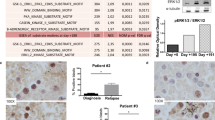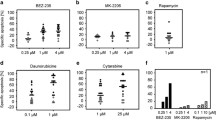Abstract
Treatment of acute myeloid leukemia (AML) remains challenging with many patients harboring unfavorable prognostic parameters such as FLT3 internal tandem duplication (FLT3-ITD) mutations leading to a constitutively activated FLT3-receptor tyrosine kinase (RTK). Activation of proteins by phosphorylation of tyrosine residues is a common mechanism in leukemia development. Therefore, specific tyrosine kinase inhibitors (TKI) have been developed for AML therapy and are currently under investigation. The staurosporine derivate PKC412 (Midostaurin) was found to be an effective inhibitor of the FLT3-RTK and is currently undergoing clinical trials for FLT3-mutated AML patients. Since resistance towards TKIs has been observed in vitro and in clinical trials, we have generated a PKC412-resistant clone (MV4-11r) of the human myelomonoblastic cell line MV4-11, which carries a homozygous FLT3-ITD mutation. MV4-11r displayed higher vitality after addition of PKC412 compared with MV4-11 with a pronounced reduction of apoptotic cells. Cytogenetic characterization revealed the acquisition of additional aberrations in the resistant cell line such as clonal alterations at chromosome 13q with additional FLT3 signals. Microarray analysis revealed significant expression changes in several genes prior to and after incubation with PKC412. The expression status of candidate genes being regulated by FLT-ITD like JAG1, p53, MCL-1, C-KIT, and FLT3/-L was confirmed by real-time PCR. In summary, resistance against PKC412 appears to be mediated by up-regulation of anti-apoptotic genes and down-regulation of proapoptotic signals as well as genes that are involved in normal and malignant hematopoiesis.








Similar content being viewed by others
References
Nakao M et al (1996) Internal tandem duplication of the flt3 gene found in acute myeloid leukemia. Leukemia 10(12):1911–1918
Stirewalt DL et al (2001) FLT3, RAS, and TP53 mutations in elderly patients with acute myeloid leukemia. Blood 97(11):3589–3595
Kiyoi H et al (1997) Internal tandem duplication of FLT3 associated with leukocytosis in acute promyelocytic leukemia. Leukemia Study Group of the Ministry of Health and Welfare (Kohseisho). Leukemia 11(9):1447–1452
Kottaridis PD et al (2001) The presence of a FLT3 internal tandem duplication in patients with acute myeloid leukemia (AML) adds important prognostic information to cytogenetic risk group and response to the first cycle of chemotherapy: analysis of 854 patients from the United Kingdom Medical Research Council AML 10 and 12 trials. Blood 98(6):1752–1759
Thiede C et al (2002) Analysis of FLT3-activating mutations in 979 patients with acute myelogenous leukemia: association with FAB subtypes and identification of subgroups with poor prognosis. Blood 99(12):4326–4335
Kiyoi H et al (1999) Prognostic implication of FLT3 and N-RAS gene mutations in acute myeloid leukemia. Blood 93(9):3074–3080
Schnittger S et al (2002) Analysis of FLT3 length mutations in 1003 patients with acute myeloid leukemia: correlation to cytogenetics, FAB subtype, and prognosis in the AMLCG study and usefulness as a marker for the detection of minimal residual disease. Blood 100(1):59–66
Whitman SP et al (2001) Absence of the wild-type allele predicts poor prognosis in adult de novo acute myeloid leukemia with normal cytogenetics and the internal tandem duplication of FLT3: a cancer and leukemia group B study. Cancer Res 61(19):7233–7239
Gale RE et al (2005) No evidence that FLT3 status should be considered as an indicator for transplantation in acute myeloid leukemia (AML): an analysis of 1135 patients, excluding acute promyelocytic leukemia, from the UK MRC AML10 and 12 trials. Blood 106(10):3658–3665
Druker BJ et al (1996) Effects of a selective inhibitor of the Abl tyrosine kinase on the growth of Bcr-Abl positive cells. Nat Med 2(5):561–566
Druker BJ et al (2001) Activity of a specific inhibitor of the BCR–ABL tyrosine kinase in the blast crisis of chronic myeloid leukemia and acute lymphoblastic leukemia with the Philadelphia chromosome. N Engl J Med 344(14):1038–1042
Meyer T et al (1989) A derivative of staurosporine (CGP 41 251) shows selectivity for protein kinase C inhibition and in vitro anti-proliferative as well as in vivo anti-tumor activity. Int J Cancer 43(5):851–856
Fabbro D et al (2000) PKC412—a protein kinase inhibitor with a broad therapeutic potential. Anticancer Drug Des 15(1):17–28
Sawyers CL (2002) Finding the next Gleevec: FLT3 targeted kinase inhibitor therapy for acute myeloid leukemia. Cancer Cell 1(5):413–415
Levis M et al (2001) A FLT3 tyrosine kinase inhibitor is selectively cytotoxic to acute myeloid leukemia blasts harboring FLT3 internal tandem duplication mutations. Blood 98(3):885–887
Propper DJ et al (2001) Phase I and pharmacokinetic study of PKC412, an inhibitor of protein kinase C. J Clin Oncol 19(5):1485–1492
Stone RM et al (2005) Patients with acute myeloid leukemia and an activating mutation in FLT3 respond to a small-molecule FLT3 tyrosine kinase inhibitor, PKC412. Blood 105(1):54–60
Weisberg E, Griffin JD (2000) Mechanism of resistance to the ABL tyrosine kinase inhibitor STI571 in BCR/ABL-transformed hematopoietic cell lines. Blood 95(11):3498–3505
Mahon FX et al (2000) Selection and characterization of BCR-ABL positive cell lines with differential sensitivity to the tyrosine kinase inhibitor STI571: diverse mechanisms of resistance. Blood 96(3):1070–1079
Weisberg E et al (2002) Inhibition of mutant FLT3 receptors in leukemia cells by the small molecule tyrosine kinase inhibitor PKC412. Cancer Cell 1(5):433–443
Mosmann T (1983) Rapid colorimetric assay for cellular growth and survival: application to proliferation and cytotoxicity assays. J Immunol Methods 65(1–2):55–63
Chomczynski P (1987) Single-step method of RNA isolation by acid guanidinium thiocyanate–phenol–chloroform extraction. Anal Biochem 162(1):156–159
Oswald J et al (2006) Gene-expression profiling of CD34+ hematopoietic cells expanded in a collagen I matrix. Stem Cells 24(3):494–500
Trautmann K et al (2005) Expression profiling of gastric cancer samples by oligonucleotide microarray analysis reveals low degree of intra-tumor variability. World J Gastroenterol 11(38):5993–5996
Affymetrix, I.a.A.I., GeneChip® Expression Analysis Technical Manual. Available at http://www.affymetrix.com/support/technical/manual/expression_manual.affx
Livak KJ, Schmittgen TD (2001) Analysis of relative gene expression data using real-time quantitative PCR and the 2(-Delta Delta C(T)) Method. Methods 25(4):402–408
Shah NP (2005) Loss of response to imatinib: mechanisms and management. Hematology Am Soc Hematol Educ Program, 183–187
Gorre ME et al (2001) Clinical resistance to STI-571 cancer therapy caused by BCR–ABL gene mutation or amplification. Science 293(5531):876–880
Hochhaus A et al (2002) Molecular and chromosomal mechanisms of resistance to imatinib (STI571) therapy. Leukemia 16(11):2190–2196
Daub H, Specht K, Ullrich A (2004) Strategies to overcome resistance to targeted protein kinase inhibitors. Nat Rev Drug Discov 3(12):1001–1010
Cools J et al (2004) Prediction of resistance to small molecule FLT3 inhibitors: implications for molecularly targeted therapy of acute leukemia. Cancer Res 64(18):6385–6389
Heidel F et al (2006) Clinical resistance to the kinase inhibitor PKC412 in acute myeloid leukemia by mutation of Asn-676 in the FLT3 tyrosine kinase domain. Blood 107(1):293–300
Growney JD et al (2005) Activation mutations of human c-KIT resistant to imatinib mesylate are sensitive to the tyrosine kinase inhibitor PKC412. Blood 106(2):721–724
Ashman LK et al (1999) Effects of mutant c-Kit in early myeloid cells. Leuk Lymphoma 34(5–6):451–461
Gottesman MM, Fojo T, Bates SE (2002) Multidrug resistance in cancer: role of ATP-dependent transporters. Nat Rev Cancer 2(1):48–58
Leu JI et al (2004) Mitochondrial p53 activates Bak and causes disruption of a Bak–Mcl1 complex. Nat Cell Biol 6(5):443–450
Zhang B, Gojo I, Fenton RG (2002) Myeloid cell factor-1 is a critical survival factor for multiple myeloma. Blood 99(6):1885–1893
Breitenbuecher F, Markova B, Kasper S (2009) A novel molecular mechanism of primary resistance to FLT3-kinase inhibitors in AML. Blood 113(7):4063–4073
Kaufmann SH et al (1998) Elevated expression of the apoptotic regulator Mcl-1 at the time of leukemic relapse. Blood 91(3):991–1000
Craig RW (2002) MCL1 provides a window on the role of the BCL2 family in cell proliferation, differentiation and tumorigenesis. Leukemia 16(4):444–454
Weijzen S et al (2002) Activation of Notch-1 signaling maintains the neoplastic phenotype in human Ras-transformed cells. Nat Med 8(9):979–986
Calvi LM et al (2003) Osteoblastic cells regulate the haematopoietic stem cell niche. Nature 425(6960):841–846
Karanu FN et al (2000) The notch ligand jagged-1 represents a novel growth factor of human hematopoietic stem cells. J Exp Med 192(9):1365–1372
Karanu FN et al (2001) Human homologues of Delta-1 and Delta-4 function as mitogenic regulators of primitive human hematopoietic cells. Blood 97(7):1960–1967
Chiaramonte R et al (2005) A wide role for NOTCH1 signaling in acute leukemia. Cancer Lett 219(1):113–120
Stirewalt DL et al (2008) Identification of genes with abnormal expression changes in acute myeloid leukemia. Genes Chromosomes Cancer 47(1):8–20
Kohlmann A et al (2003) Molecular characterization of acute leukemias by use of microarray technology. Genes Chromosomes Cancer 37(4):396–405
Valk PJ et al (2004) Prognostically useful gene-expression profiles in acute myeloid leukemia. N Engl J Med 350(16):1617–1628
Bullinger L, Valk PJ (2005) Gene expression profiling in acute myeloid leukemia. J Clin Oncol 23(26):6296–6305
Acknowledgments
The skilful technical assistance of M. Karger and D. Grossmann is highly acknowledged.
Author's disclosures of potential conflicts of interest
C. T. has received research funding from Novartis.
Author information
Authors and Affiliations
Corresponding author
Electronic supplementary material
Below is the link to the electronic supplementary material.
ESM
(PDF 35 kb)
Rights and permissions
About this article
Cite this article
Stölzel, F., Steudel, C., Oelschlägel, U. et al. Mechanisms of resistance against PKC412 in resistant FLT3-ITD positive human acute myeloid leukemia cells. Ann Hematol 89, 653–662 (2010). https://doi.org/10.1007/s00277-009-0889-1
Received:
Accepted:
Published:
Issue Date:
DOI: https://doi.org/10.1007/s00277-009-0889-1




